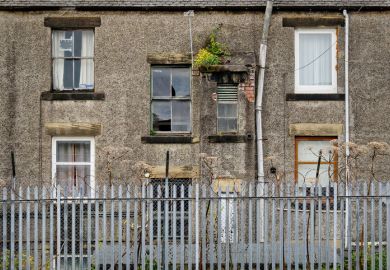Undergraduate enrolment at US colleges and universities fell again this semester, with a record two-year decline bolstering fears that nationwide problems in higher education go well beyond the Covid pandemic.
Total enrolment appears to be down 3.2 per cent, according to the National Student Clearinghouse Research Center, after last year’s loss of 3.4 per cent, signally the worst two-year retreat in 50 years.
“Enrolments are not getting better” with the easing of Covid-related restrictions, Doug Shapiro, executive director of the research center, said in announcing the data. “They’re still getting worse.”
The Clearinghouse is a non-profit organisation that works on behalf of 97 per cent of US institutions, and its first report on autumn 2021 enrolment covers data from slightly more than half of them.
The percentages could shift as the Clearinghouse compiles data from additional campuses. But Dr Shapiro offered no reason to expect any meaningful changes in the percentages, and higher education leaders – especially those in the hard-hit sectors of public community colleges and small private institutions – began to acknowledge the need to accelerate their plans for accommodating the nation’s fast-approaching decline in the number of high school graduates.
The numbers are “quite a surprise,” said David Baime, vice-president for government relations at the American Association of Community Colleges, after enrolment in the two-year sector lost nearly 6 per cent, following last autumn’s retreat of 9 per cent.
Overall public four-year enrolment is down 2.3 per cent, after dropping nearly 1 per cent last fall. Enrolment at highly selective state flagship institutions grew 1 per cent while their less selective counterparts shrank by more than 5 per cent.
Private non-profit four-year institutions also lost less than 1 per cent of their overall enrolment, but with similar variations. The most highly selective private institutions expanded by 4.3 per cent to exceed their pre-pandemic levels, while other private non-profit four-year campuses lost about 2 per cent.
The situation, experts said, appears to reflect the nation’s ongoing economic divide and its Covid-era exacerbation, with the overall economy going through a recession but some key sectors eager for workers and offering wage incentives.
In those circumstances, Dr Shapiro said, “a lot of young people seem to be going to work instead of going to college.” Such potential students, he said, “have always been most on the margin between college and the workforce, and the need to support their families through hard times.” That will raise a future need, he said, to help get them back on a college pathway.
Small private colleges are making similar assessments about economic divisions, said Marjorie Hass, president of the Council of Independent Colleges. The Clearinghouse data reinforce “some of the thing we have suspected – that is that the pandemic did not hit all students equally,” said Dr Hass, the former president of Rhodes College and Austin College.
Many small private colleges, however, have been facing the demographic reality of enrolment declines for years and been taking steps to shore up their finances, Dr Hass said.
Community colleges, however, are deeply troubled by the declines, Mr Baime said, feeling they could suggest a problem not easily explained by the usual cycles of enrolment growth at times of economic trouble. The enrolment news also comes only days after President Biden conceded that Congress is not likely to approve his plan to make all two-year institutions tuition-free.
Dr Hass acknowledged that she is among the leaders in the four-year sector who prefer that Congress direct student aid toward the Pell Grant programme, the main federal subsidy for low-income students, because it benefits all institutions and is reserved only for those with demonstrated economic need. At the same time, she said, her association’s members are eager to find more and better ways of helping students transfer credits earned at two-year public colleges toward four-year degrees.
There was also wide variation, mostly between the undergraduate and graduate levels, in the enrolment of foreign students in the Clearinghouse data. At the undergraduate level, foreign student numbers are down more than 8 per cent this autumn, as part of a two-year total decline of 21 per cent. At the graduate level, however, foreign student enrolment surged 13 per cent, after an 8 per cent loss last autumn. That allowed overall graduate student enrolment in the US to increase 2 per cent this autumn.
The difference, said Mikyung Ryu, the Clearinghouse’s director of research publications, could reflect the added financial aid and scholarship opportunities that are available to foreign students at the graduate level.
Enrolment at for-profit US four-year colleges appears to be down nearly 13 per cent, after holding almost steady last fall, although the Clearinghouse warned that the sector’s numbers were most susceptible to revision in coming weeks as relatively few for-profit institutions provided data in time for its initial enrolment report.
Register to continue
Why register?
- Registration is free and only takes a moment
- Once registered, you can read 3 articles a month
- Sign up for our newsletter
Subscribe
Or subscribe for unlimited access to:
- Unlimited access to news, views, insights & reviews
- Digital editions
- Digital access to THE’s university and college rankings analysis
Already registered or a current subscriber?







